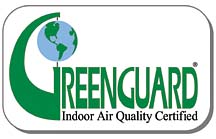
The Greenguard Environmental Institute is based in Washington, D.C.; however, it is a global, nonprofit organization with a third-party board to establish environmental standards for indoor products and building materials.
According to the institute, "Our goal is to improve public health and quality of life by encouraging and helping manufacturers to build better, safer products and to uphold environmental practices in product development, manufacturing, and distribution. We are an independent organization and not affiliated with or sponsored by any manufacturer or industry."
The institute calls its certification and labeling program for interior products and building materials "the only testing program worldwide for low-emitting products." The institute oversees the certification process, including all audits and qualifying criteria for each product category.
"Our board members are world-renowned for their expertise in chemical emissions testing, indoor air quality, and public health."
One manufacturer recently spoke about its one-year anniversary with the program. "Since CertainTeed's announcement in January 2003 that all of its insulation products - including the HVAC and mechanical insulation product line - would be certified for superior IAQ performance by the Greenguard Environmental Institute, the response has been very positive," said Tom Newton, manager of advertising and promotion for CertainTeed Corp.'s Insulation Group.
"The third-party assurance that the products are certified for lower emission of contaminants is taking the worry out of the insulation decision for specifiers, contractors, and end users alike."
More than ever before, HVAC contractors need to make IAQ a focal point in their businesses. "With people spending more time inside, IAQ is more important than ever, especially for individuals with respiratory ailments like asthma and allergies," explained Newton. "In addition, educated consumers are searching out products that they know will not negatively impact their health."
He added that manufacturers with Greenguard-certified products "can give people independent assurance of IAQ excellence, while allowing developers, builders, and contractors to capitalize on the growing green building trend."
Moreover, Greenguard has been recognized by the U.S. Green Building Council's Leadership in Energy and Environmental Design (LEED) program; using Greenguard-certified products is one measure to obtain LEED-CI (Commercial Interior) credits. "These enable businesses to qualify for a growing array of state and local government incentives," explained Newton.
To educate the professional market, CertainTeed produced a brochure explaining the Greenguard process for CertainTeed Fiber Glass Insulation. In addition, the company is making a brochure available to consumers on "How to Build an Environmentally Responsible Home." It outlines items the consumer can discuss with builders in order to build an environmentally responsible home, Newton said, including using Greenguard-certified products. "The idea is to create a demand for the product."
The certification program includes all construction materials, furnishings, furniture, office equipment, cleaning and maintenance materials, and processes that are used in interior environments.
Products are tested for emissions of formaldehyde, volatile organic compounds (VOCs), respirable particles, ozone, and other pollutants using stringent environmental chamber protocols.
For more information on Greenguard, visit www.greenguard.org. For information on the CertainTeed literature, visit www.certainteed.com.
Publication date: 01/19/2004

Report Abusive Comment